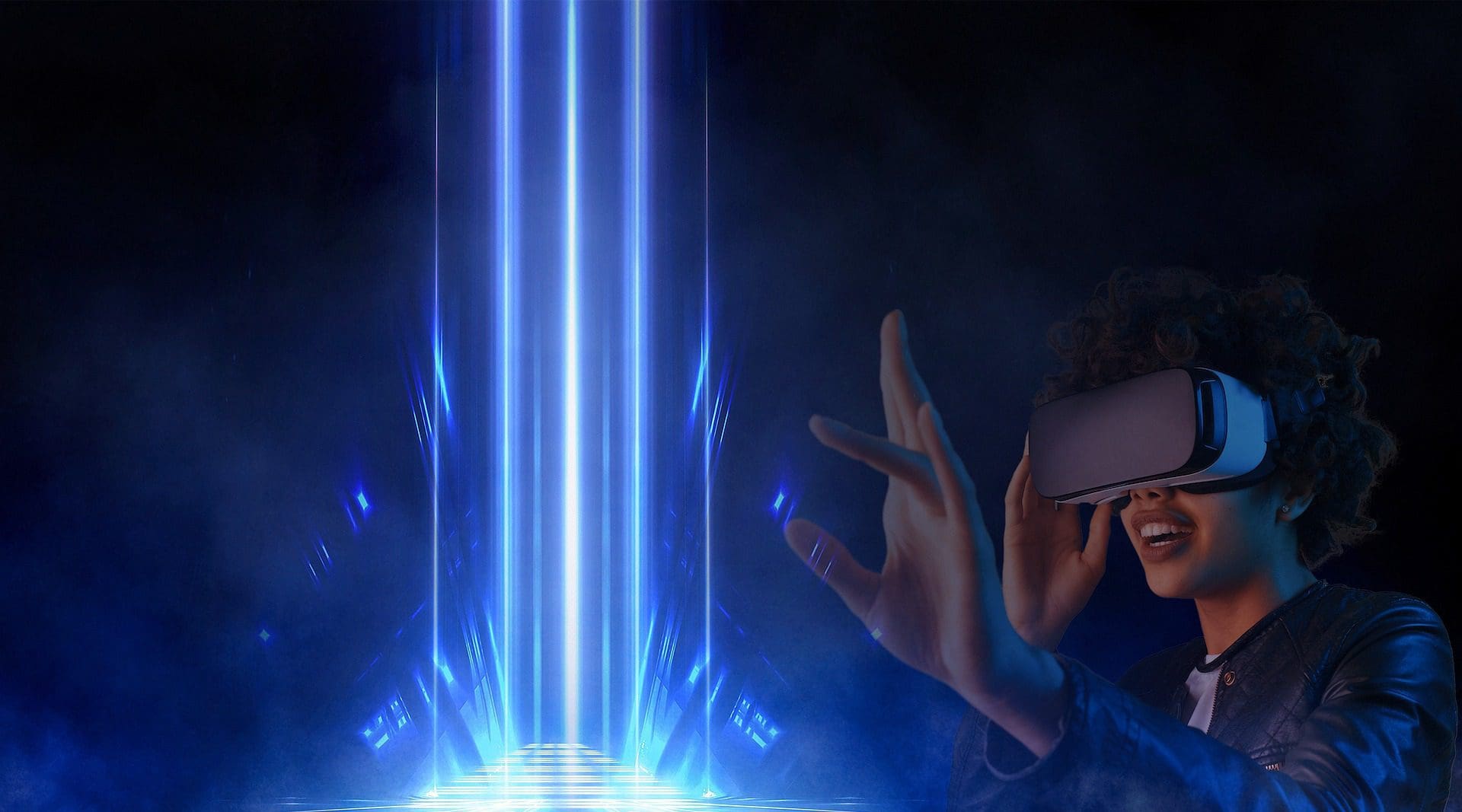Metaverse: the future is getting closer
Today we will answer one of the hottest questions of the moment: what is the metaverse?. It is a central topic in the global narrative, attentive to by the most influential Big Tech and a dream of every kid born in the transition to the digital age.
When we talk about the Metaverse, immediately our brains conjure up images of floating avatars, spaceships and finger-zooming holograms. This is certainly stimulating for science fiction fans; however, the applications of metaverse technologies are increasingly penetrating into the daily lives of each of us.
What is the metaverse in simple terms?
Let us then discover the metaverse meaning, and then move on to some additional details. Future applications and the macro domains that are already emerging will increasingly help to develop appropriate and precise definitions as we develop context-specific terminology.
For now, to the question “what is the metaverse?”, we can answer as follows: The Metaverse is a digital representation of a virtual world, explorable in the first person through avatars, creating a real fusion between the real and digital worlds. The metaverse is thus a true virtual universe in which we find endless possibilities.
This definition is especially true when we talk about Virtual Reality. In fact, we find ourselves immersed, via visor or via screen, in an illusory world, within which we can move around, interact with the infrastructure present and with the avatars of other users.
Augmented and mixed reality
However, there is another aspect related to the metaverse that is gaining momentum, fueling attention to this world: the possibility of interacting with digital infrastructures, built on virtual layers superimposed on the real world.
Put like that, it may sound complex. To make it simple, thanks to more or less invasive devices we will be able to perceive the reality around us, enriched with two- and three-dimensional elements: we are talking about augmented reality.
Completing the discussion, we also introduce the concept of mixed reality; this is an area that merges what we have talked about so far, increasingly reducing the boundary separating real and virtual.
For example, you can play a game in virtual reality and interact with physical objects in the room you are in. Take a sip of ice water and you’ll be able to hit enemies with the bottle in your hand. Not bad, don’t you think?
How does the metaverse work? Blockchain and NFT
The fusion of blockchain, decentralization and the metaverse makes users owners of their digital identity and associated assets. This is made possible by the certification of ownership, uniqueness and authenticity, which is also conferred by the introduction of NFTs.
This feature is vital and new: every virtual or augmented reality developed to date centralizes ownership of what is built into it; all for the benefit of boards and shareholders, at the expense of users.
Through decentralization we become owners of our assets and our digital identity. We are free to move from one metaverse to another, with no possibility of being turned off, banned or excluded from our properties.
Where is the metaverse located?
As we discovered in the previous section, the metaverse makes great support of blockchain technology.
In truth, it is not indispensable, but it enables this virtual world to offer superior opportunities and functionality both quantitatively and qualitatively.
Depending on the metaverse, because there are a variety of them, it can therefore be located:
- On a central server, owned by the company behind it;
- Distributed on a blockchain, thus lacking a precise physical location.
So, if your question was “does the metaverse exist?” you can say “yes, it does”.
How do I get into the metaverse?
Let us see how to enter the metaverse.
Since these are in truth metaverses, there is no precise way to enter it: it all depends on which one we are interested in.
For example, The Sandbox metaverse requires a crypto wallet such as MetaMask; it is accessed directly from the metaverse portal, sandbox.game. Same thing if we were interested in Decentraland, with the difference that we would have to go to the official website of this project, decentraland.org.
When the Meta metaverse is ready, there will undoubtedly be a portal that will serve as a gateway. Nike metaverse? Same discussion.
By now we should have an understanding of the procedure: we locate the metaverse we are interested in, search for the official site (utmost attention to possible scams) and follow the instructions to join.
Who owns metaverse?
There is no owner because there are many projects. In centralized realities, it will be the company (or companies) behind it that will have ownership. When dealing with decentralized projects, it depends.
What is a metaverse company? It’s a company that operates in this area. An example is Meta, formerly facebook, still run by one of the founders Mark Zuckerberg.
“There is no single owner of the metaverse because the projects are numerous.”
Technology and progress
This is all great. Pero, every innovation encounters numerous difficulties along the way to becoming established. First of all, technological adaptation.
What will surely help will be the intervention of some Big Company that will start marketing products at affordable prices, adapting to the increasingly high graphic standards by rendering with photorealistic effects.
Artificially altered perception of space and reality with the resulting physiological discomforts are problems that are already part of the narrative of this technology. Each manufacturer seeks to innovate and remedy the problem, creating the competition that will inevitably lead to progress.

What is the metaverse: mass adoption
To import this new paradigm within its habits, humanity will have to perform a real physiological effort: new habits, gestures and different movements.
From how society has developed in recent years with respect to new technologies, we know that mass adoption has always come through Gaming and Social interaction; this is because they allow us to become familiar with technology in a more natural way.
Along with the economic incentive, we have seen how these two drivers have led to great adoption for major streaming, social, gaming, and content creation platforms. As well as being major vectors driving trends in the crypto sector, as observed over the past year.
Current applications of the metaverse
The goal is to create synergies between the real and digital worlds in order to enrich one’s daily life experiences:
- Smartworking;
- Entertainment;
- Shopping experiences;
- Remote assistance;
- Real Estate.
On the artistic side, artists are asked to express all their creativity by exhibiting their works in virtual galleries. Here they will be able to sell them through dedicated metaverse marketplaces developed ad hoc. As we have seen so far, blockchain technology has been very effective, in certifying the authenticity of digital works.
The big fashion houses, have already started collaborating with digital designers and stylists to produce lines of avatar accessories.
It will not surprise any of us, if in the future we can visit digital showrooms of our favorite brands, immersed in the shopping experience via more or less immersive digital devices (NikeLand on Roblox). In this article we talked about the metaverse projects to watch out for.
Virtual spaces, where applications and infrastructure can be built, are becoming increasingly sought after due to the influx of people on the platforms, as well as the business possibilities that can be developed within them. Think, for example, of the real estate crowds on The SandBox and Decentraland.
Many of these projects integrate their own cryptocurrencies, all of which can be purchased on major crypto exchanges, most notably Binance. Click on the link to take advantage of 20 percent off lifetime fees.
Metaverse: conclusions
The Metaverse will be a great opportunity for the human being. It will have to prove that it can promote ethical innovation, thanks to a new “testnet” full of untapped potential.
Giving birth to a new digital economy would be regenerative sap for the current economy anchored in obsolete systems. An incubator of brilliant new ideas could be born, as we have seen the Internet has been in years past.
It will still take time and the lack of programmers certainly does not help. In all likelihood several platforms and infrastructures will be filled with junk or have serious security problems. The path will not be easy or immediate; in the end, however, the end result could radically change everyone’s life.
The evolution of the regulatory fabric regarding data protection and consumer protection will also have to be closely watched. Of course, hoping that at least this time they can create an ad hoc text and not try to dress the new in old clothes, as they have done so far.
We will periodically post updates on major developments in this area, placed among the leaders in the innovation trench, just where we like to be!
This news is republished from another source. You can check the original article here







